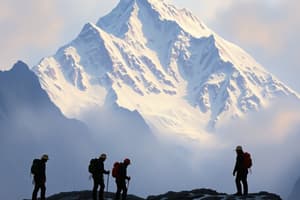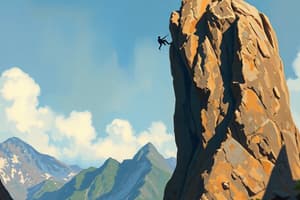Podcast
Questions and Answers
What should you do while walking in the direction of the DTA?
What should you do while walking in the direction of the DTA?
- Turn the bezel away from the DTA.
- Align the compass needle with the south line inside the compass housing.
- Hold the compass above eye level for better visibility.
- Keep the red needle aligned with the magnetic north arrow. (correct)
Which statement about bearings is correct?
Which statement about bearings is correct?
- Bearings can be greater than 180°.
- Bearings are always expressed in degrees with a directional suffix. (correct)
- Bearings are represented as full-circle angles.
- Bearings exist only within quadrants and are less than 90°.
How would you convert an azimuth of 190° to a bearing?
How would you convert an azimuth of 190° to a bearing?
- S190°W
- N10°E
- S10°W (correct)
- N190°E
In a traverse, what does 'leg' refer to?
In a traverse, what does 'leg' refer to?
What is the correct representation for an azimuth of 40° in bearing format?
What is the correct representation for an azimuth of 40° in bearing format?
Which of the following is NOT a form of climbing mentioned?
Which of the following is NOT a form of climbing mentioned?
What was a significant event in the history of mountaineering in 1786?
What was a significant event in the history of mountaineering in 1786?
What is the percentage of carbohydrates recommended in the nutritional considerations for hiking?
What is the percentage of carbohydrates recommended in the nutritional considerations for hiking?
Which statement about trekking is accurate?
Which statement about trekking is accurate?
Which class indicates a very easy trail according to the classification of mountains?
Which class indicates a very easy trail according to the classification of mountains?
What is the minimum hydration requirement for hiking?
What is the minimum hydration requirement for hiking?
Which individual became the first Filipina to climb all Seven Summits?
Which individual became the first Filipina to climb all Seven Summits?
What is the correct calorie distribution for a 2,000-calorie day for protein?
What is the correct calorie distribution for a 2,000-calorie day for protein?
What is the primary purpose of hiking at an easy pace initially?
What is the primary purpose of hiking at an easy pace initially?
Which layer of clothing is recommended for warmth during hiking?
Which layer of clothing is recommended for warmth during hiking?
What is the benefit of using trekking poles during hikes?
What is the benefit of using trekking poles during hikes?
Which of the following is NOT a safety reminder when hiking?
Which of the following is NOT a safety reminder when hiking?
How does regular hiking impact body composition?
How does regular hiking impact body composition?
Orienteering is primarily used for which purpose?
Orienteering is primarily used for which purpose?
What does the term 'Pace Factor' refer to in navigation?
What does the term 'Pace Factor' refer to in navigation?
Which of the following is a key component of an orienteering map?
Which of the following is a key component of an orienteering map?
What is magnetic declination?
What is magnetic declination?
What is the main function of a prismatic compass component?
What is the main function of a prismatic compass component?
Which equipment is essential for safe hiking?
Which equipment is essential for safe hiking?
What does the 'Leave No Trace' principle emphasize?
What does the 'Leave No Trace' principle emphasize?
For overnight hikes, what is the recommended backpack capacity?
For overnight hikes, what is the recommended backpack capacity?
What should you do with the compass during navigation?
What should you do with the compass during navigation?
Flashcards
Mountaineering
Mountaineering
Sport of attempting to reach high points in mountainous regions for the enjoyment of the climb.
Rock Climbing
Rock Climbing
Type of mountaineering that involves climbing natural rock formations, slopes, and possibly dealing with avalanches.
Ice Climbing
Ice Climbing
Type of mountaineering that involves climbing glaciers and frozen waterfalls.
Mixed Climbing
Mixed Climbing
Signup and view all the flashcards
Trekking
Trekking
Signup and view all the flashcards
Visualization
Visualization
Signup and view all the flashcards
Hiking Nutrition
Hiking Nutrition
Signup and view all the flashcards
Total Daily Energy Expenditure (TDEE)
Total Daily Energy Expenditure (TDEE)
Signup and view all the flashcards
Bearing
Bearing
Signup and view all the flashcards
Azimuth
Azimuth
Signup and view all the flashcards
Azimuth to Bearing
Azimuth to Bearing
Signup and view all the flashcards
Traverse
Traverse
Signup and view all the flashcards
Station
Station
Signup and view all the flashcards
Pace Factor
Pace Factor
Signup and view all the flashcards
Magnetic Declination
Magnetic Declination
Signup and view all the flashcards
Orienteering Map
Orienteering Map
Signup and view all the flashcards
Topographic Map
Topographic Map
Signup and view all the flashcards
Baseplate Compass
Baseplate Compass
Signup and view all the flashcards
Prismatic Compass
Prismatic Compass
Signup and view all the flashcards
Cardinal Directions
Cardinal Directions
Signup and view all the flashcards
Ordinal Directions
Ordinal Directions
Signup and view all the flashcards
Orienteering Map
Orienteering Map
Signup and view all the flashcards
Orienteering
Orienteering
Signup and view all the flashcards
Using a Compass (Baseplate)
Using a Compass (Baseplate)
Signup and view all the flashcards
Hiking Pace
Hiking Pace
Signup and view all the flashcards
Hip Belt (Backpack)
Hip Belt (Backpack)
Signup and view all the flashcards
Safety Reminders (Hiking)
Safety Reminders (Hiking)
Signup and view all the flashcards
Trekking Poles (Hiking)
Trekking Poles (Hiking)
Signup and view all the flashcards
Study Notes
Hiking and Trekking/Mountaineering
- Definition (Mountaineering): Attaining or attempting high mountain summits for enjoyment of the climb.
- European Context: Emphasizes technical climbing using equipment at high altitudes.
- Forms: Rock climbing/bouldering, snow/ice climbing, mixed climbing.
- Local Setting: Hiking (shorter, well-marked trails) and trekking (longer, varied terrains).
Brief History of Mountaineering
- Europe (mid-18th century):
- Chamonix Valley: Glaciers observed and fascination with Mont Blanc.
- Horace-Benedict de Saussure offered a reward for Mont Blanc summit.
- 1786: Michel Gabriel Paccard and Jacques Balmat first summit.
- 1808: Marie Paradis first woman to reach the peak.
- Philippines (1880): Don Joaquin Rajal led the first expedition to Mt. Apo.
- Philippines (2012): Romeo Garduce first Filipino to scale the Seven Summits, Carina Dayondon first Filipina.
Classification of Mountains in the Philippines
- Trail Classes (1-9): Difficulty scale from 1 (very easy, 90-minute treks) to 9 (extremely difficult).
Mental and Emotional Preparation
- Visualization and affirmations: Essential for mental strength.
Planning a Hike
- Research: Weather, terrain, trails.
- Itineraries: Share plans with family for monitoring.
Nutritional Considerations for Hiking
- Macro-nutrients: 15% protein, 50-65% carbohydrates, 20-35% fats.
- Calorie Example (2,000 calories): 75g protein, 325g carbohydrates, 45g fat.
- Calorie Values: 4 calories/gram for carbohydrates and protein, 9 calories/gram for fat.
- Food requirements: 1.5 – 2.5 lbs of food per day (2500-4500 calories).
Hydration for Hiking
- Minimum: 1-2 liters per day, increase with load/temperature.
- Formula +1L for every 4-5 miles; drink 1/2 to 1 cup every 30-45 minutes.
Basic Hiking Skills
- Pace: Start slow, adjust based on breathing (normal=increase, hard=slow).
- Rhythm: Sync breathing with steps/arms.
- Uphill: Smaller steps, maintain pace.
- Breaks: Take short breaks, eat small, frequent meals.
Health Benefits of Hiking/Trekking
- Cardiovascular: Improves O2 efficiency, endurance.
- Lung Strength: Increases oxygen flow/capacity.
- Bone/Muscle: Mimics weight training.
- Body Composition: Supports healthy weight maintenance.
Hiking Safety
- Groups: Hike with others, not alone.
- Skills: Stay within trails and skill level.
- Guides: Follow instructions.
- Leave No Trace: Important to minimize environmental impact.
- Emergency Planning
- First Aid: Knowledge critical.
Hiking Essentials
- Clothing: Base, insulating, outer layers (waterproof/breathable).
- Backpack: Day hikes: 30-50L; overnight: 50-80L.
- Footwear: Hiking shoes (easy trails), boots (rough terrain), backpacking boots (long/difficult).
- Socks: Nylon/merino, avoid cotton.
- Trekking poles: For balance, knee support, and depth checks.
- Navigation: Map, compass, GPS.
- Sun Protection: Eyewear, clothing, sunscreen.
- Headlamp: Preferred over flashlight.
- Personal safety accessories: Knife, first aid kit, lip balm.
Orienteering
- Definition: Using a map and compass to navigate unfamiliar terrain.
- Uses: Search-and-rescue, park rangers, outdoor enthusiasts.
Orienteering History
- Scandinavia (1886): Military use.
- Ernst Killander (1919): Designed cross-country competitions.
- IOF (1941-1943): International Orienteering Federation formed.
- US Marine Corps (1967): Became part of the Physical Fitness Academy.
- US Olympic Committee (1988): Accepted as a sport.
- Philippines (2020): Became the 76th member of the IOF.
Orienteering Essentials
- Map and compass.
- Whistle.
- Map bag.
- Pen/marker.
Orienteering Map Use
- Types: Locator, highway, topographic, orienteering.
Measuring Distance (Terrain)**
- Pace Factor: Calculate paces to know a distance (e.g., convert 'X' paces = 'Y' meters.)
Compass Usage Techniques
-
Compass Types: Prismatic, baseplate.
-
Key parts:
- Direction of Travel Arrow (DTA)
- Bezel
- Compass Needle
- Thumb Ring
- Centimeter and Inch Scale
- Lanyard
- Baseplate
-
Bearings & Azimuth:
- Bearing: Angle within quadrant.
- Azimuth: Full-circle angle (0-360° clockwise from North).
-
Conversion: Convert azimuth to bearing (example: Azimuth 40° = N40°E).
-
Magnetic Declination: Difference between true north and magnetic north; varies by location.
-
Grid North: Direction along map projection grid lines.
Studying That Suits You
Use AI to generate personalized quizzes and flashcards to suit your learning preferences.






